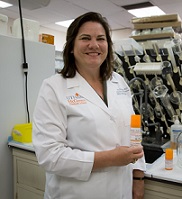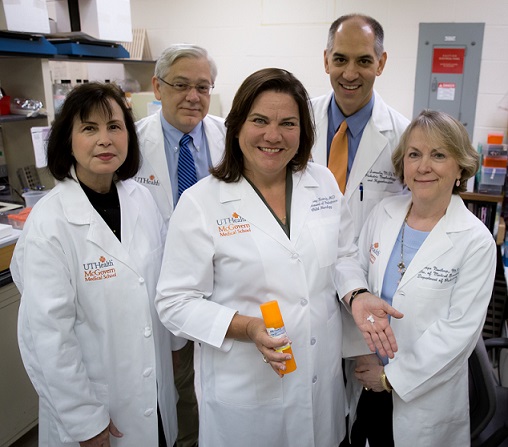Tuberous Sclerosis Complex
Topical Rapamycin Therapy to Alleviate Cutaneous Manifestations of Tuberous Sclerosis Complex
Posted June 8, 2018
Mary Kay Koenig, M.D., University of Texas Medical School at Houston

Credit: Maricruz Kwon, UTHealth Houston
One of the many manifestations of tuberous sclerosis complex (TSC) is the development of angiofibromas (red bumps on the face, especially on the nose and cheeks) that can slowly enlarge and cause significant textural changes to the skin. Although facial angiofibromas are not life-threatening, they cause notable disfigurement and are one of the most significant features of TSC that impact a patient's life. Currently, there is no effective method for preventing or permanently removing the angiofibromas. mTOR inhibitors, such as rapamycin, are used as a first line of treatment for TSC. However, taken by mouth, rapamycin has side effects such as mouth sores, increased cholesterol, blood-clotting problems, acne, increased risk of infections, and poor wound healing that limit its use to treat the skin symptoms of TSC.
Knowing how beneficial mTOR inhibitors have been in TSC therapeutics, Dr. Koenig at the University of Texas aimed to find a rapamycin topical therapy that could be used in those who were not candidates for oral therapy or could be used in combination with oral therapy to improve efficacy. With funding from the Tuberous Sclerosis Complex Research Program, Clinical Research Award - Optional Collaborator, Dr. Koenig established a multicenter clinical trial to: (1) complete the preclinical approval and evaluation process of the topical product to ensure purity, bioavailability, stability, and lack of cumulative irritation; (2) determine whether topical rapamycin reduces facial angiofibromas in TSC; and (3) evaluate safety and confirm the lack of systemic uptake. Dr. Koenig and her team successfully formulated and optimized the drug and controls. When tested in patients (NCT01031901), the formula was well-tolerated; there were no systemic absorption; and no significant adverse events. Moreover, it was shown to be efficacious, with a dose response improvement when comparing a placebo to the treatment arms.
All sites were trained on data collection to ensure the accuracy and reproducibility of the results. The 10 TSC Centers were able to enroll an astounding number of patients (179!).
Dr. Koenig notes that "Clinical research is very time-consuming and effort-intensive. It takes a village to perform a study such as this." In addition to her team at the University of Texas Health Science Center at Houston (Dr. Adelaide Hebert, Dr. Hope Northrup, Dr. Joshua Samuels, Dr. John Slopis), Dr. Koenig is thankful to the investigators at the collaborating sites for their participation in this ground-breaking research: Dr. Martin Bebin (University of Alabama, Birmingham); Dr. Michael Frost (Minnesota Epilepsy Group); Dr. Steven Sparagana (Texas Scottish Rite Hospital); Dr. Elizabeth Thiele (Harvard); Dr. Darcy Krueger (Cincinnati Children's Hospital); Dr. Tanjala Gipson and Dr. Rachael Kuperman (Children's Hospital of Oakland); Dr. Joyce Wu (University of California, Los Angeles); and Dr. David Mowat (Sydney Children's Hospital), as well as to the Tuberous Sclerosis Alliance USA and Australia for their support. Dr. Koenig plans to perform a follow-up study to confirm these exciting results, with an ultimate goal of petitioning the U.S. Food and Drug Administration for a formal indication for the treatment of facial angiofibromas.
Since angiofibromas in individuals affected with TSC represent a major quality-of-life concern, the impact of this study is invaluable. Dr. Koenig notes that: "The face is our window to the world, and when you look different from everyone else, it impacts your confidence and your ability to interact with others. This treatment will help those with TSC become more like everyone else."

*McGovern Medical School at UTHealth in Houston
**The University of Texas MD Anderson Cancer Center
Credit: Maricruz Kwon, UTHealth Houston
References:
Koenig MK, Hebert AA, Roberson J, et al. 2012. Topical rapamycin therapy to alleviate the cutaneous manifestations of tuberous sclerosis complex: a double-blind, randomized, controlled trial to evaluate the safety and efficacy of topically applied rapamycin. Drugs in R&D.
Koenig MK, Bell CS, Hebert AA, et al. 2018. Efficacy and Safety of Topical Rapamycin in Patients With Facial Angiofibromas Secondary to Tuberous Sclerosis Complex: The TREATMENT Randomized Clinical Trial. JAMA Dermatology. Published online May 23, 2018. doi:10.1001/jamadermatol.2018.0464 Link:
Last updated Wednesday, March 12, 2025














